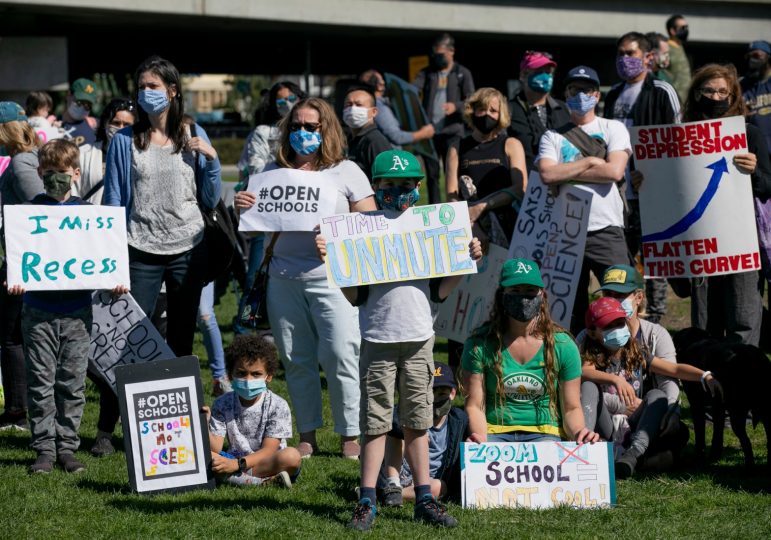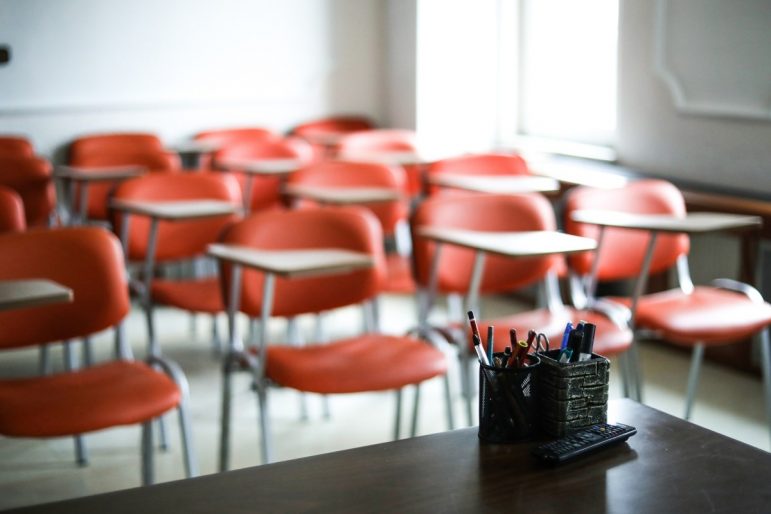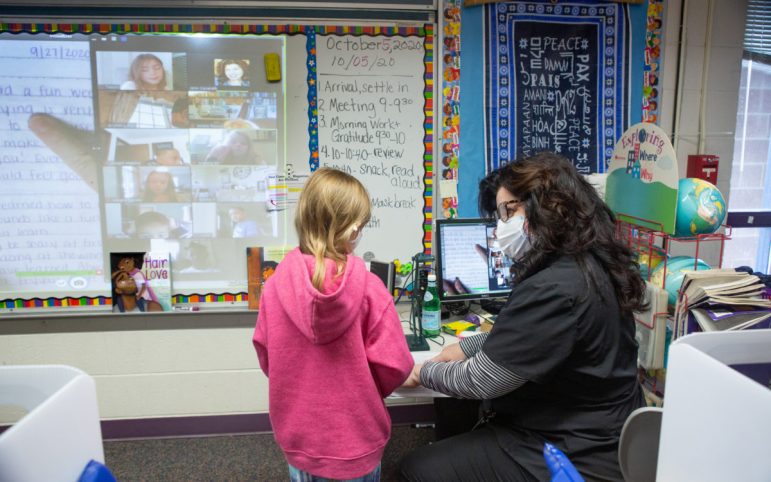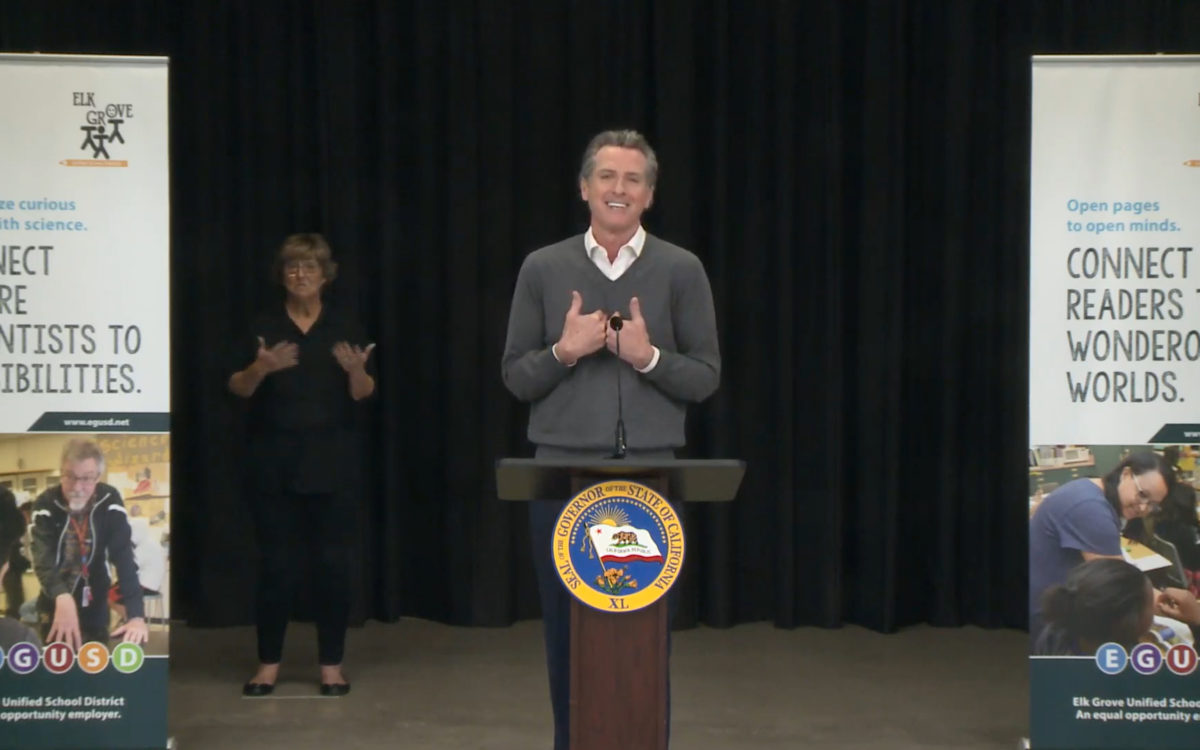Gov. Gavin Newsom and the Legislature have struck a deal to accelerate the reopening of school campuses by moving up the deadline to send the youngest students back to class in March. They also are adding $2 billion in incentives and removing obstacles that districts had complained were standing in their way.
Newsom, Assembly Speaker Anthony Rendon, D-Paramount, and Senate President pro Tem Toni Atkins, D-San Diego, announced the framework on Monday. It provides some of the key elements that Newsom had been pressing for during more than a month of protracted negotiations.
The deal also settles details for an additional $4.6 billion in one-time state funding that Newsom had proposed in his state budget for districts to spend coping with the harm from Covid-19 on students’ learning and mental health. That money, which enable can be spent though the next fiscal year, will be released with the $2 billion.
Under the terms, by April 1, districts must open kindergarten through second grade classrooms in order to receive their share of the $2 billion in incentive funding. They also must bring back to school cohorts of students in all grades most harmed by the pandemic. These include homeless and foster youth, English learners, chronically absent students and students without access to the internet and students with disabilities.
This provision will apply to all districts, including those in the “purple tier,” the most restrictive level under the state’s four-tier system governing business and community activities, provided the daily average rate of Covid infections is below 25 positive cases per 100,000 county residents.
Districts must then reopen all elementary grades and at least one grade in middle school or high school, once Covid infection levels in their county decline to the “red tier,” the second-most restrictive level. Currently, only 11 of the state’s 58 counties, mainly rural counties, are in red or orange, the next level down. However, Newsom said at a press conference Monday that he expects counties with the majority of students will move from purple to red tier by April 1.
Under the current state guidelines, middle and high schools may open in the red tier. Under the deal, districts must open at least one grade from 7 to 12 either full-day or in a hybrid model, to get the extra money.
Newsom said he is confident that once schools build confidence by reopening for a few grades, the momentum will build for more students and additional grades. “Once you dip your toe in, once you build a cohort confidently, once you build trust,” he said, parents will be less reluctant to send their children back and teachers less hesitant to go back.
The money will be distributed based on the Local Control Funding Formula, which provides extra funding for high-priority students groups: English learners, low-income students, homeless and foster children. After April 1, districts will lose 1% per day of their potential funding until they reopen campuses. Districts that don’t open by May 15 will lose eligibility for funding. But parents who were looking to Newsom and the Legislature to mandate, not incentivize, schools to reopen sharply criticized the deal.

“This isn’t a breakthrough, it’s a failure,” said Pat Reilly, a parent of two students in Berkeley Unified and advocate with OpenSchoolsCA, a new organization of parents demanding reopening all schools now. “Make no mistake, there will still be closed schools and kids left behind a month from now and months afterwards until the governor, Legislature or the courts force them open.”

Many school districts already had been moving toward reopening early grades this month, and the deal will pressure remaining districts and unions to settle quickly to take advantage of the funding and respond to growing pressure by some parents to reopen now. Unions in some districts have said employees would not return until Covid infections fall to “orange,” the tier below red, which could make for difficult negotiations.
San Francisco Unified, which negotiated last month to open in orange, is one of those districts. On Monday, Superintendent Vincent Matthews sounded pessimistic in a statement. “Though I wish it could, the governor’s announcement does not change our timeline because there are still many steps we need to take to get there and many of those aren’t able to be expedited, even with financial incentives. Make no mistake, we share the urgency to offer in-person instruction to as many students as soon as possible and more resources will help. We are getting closer each day.”
Covid vaccinations have been a point of contention. The California Teachers Association and employee unions in Los Angeles Unified and other large districts have taken the position that teachers need to be fully immunized, with two shots and a two-week incubation period, before setting foot in a classroom.
Newsom has expedited vaccinations for school staff, ordering that counties set aside at least 10% of weekly vaccines for them — about 75,000 doses. On top of that he has committed 25,000 doses over the next two weeks to Los Angeles Unified, the nation’s second largest district — an amount that Superintendent Austin Beutner said would be needed for all elementary school staff.
“This is a game-changer, I want to thank Governor Newsom for putting equity first, and for being such a strong partner to the families and staff of Los Angeles Unified,” Beutner said Monday.
Cecily Myart-Cruz, president of United Teachers Los Angeles, however, was unmoved. “Until we are out of the purple tier, until staff has been given access to vaccines, and until we have robust health and safety measures at each school,” she said, “we will not accept an arbitrary return to school date.”
“If you condition funding on the reopening of schools, that money will only go to white and wealthier and healthier school communities that do not have the transmission rates that low-income Black and Brown communities do. This is a recipe for propagating structural racism and it is deeply unfair to the students we serve.”
The wording of the deal between Newsom and legislative leaders, which the Legislature could pass as early as Thursday, specifically will state that vaccinations are not a prerequisite for reopening schools.
Newsom and legislative leaders resolved two other issues that districts called obstructions to reopening campuses and in both instances sided more with superintendents than school employee unions.
Under the governor’s initial plan for reopening schools, which he proposed in December, school districts that weren’t already open would have had to take on extensive Covid testing of students and staff, as often as weekly if they are in the purple tier. Districts complained this would be expensive and logistically burdensome. Unions said extensive testing would be an essential element for safety. Legislation that legislative leaders proposed last month, also endorsed testing tied to color tiers in the state’s infection monitoring system.

Under the revised version of Senate Bill 86, the state would financially underwrite the cost of testing but would not require it of districts already open or whose school boards approve an agreement to reopen by April 1 without extensive testing. After April 1, the state’s guidelines for testing would become a mandate for late-to-reopen districts.
The federal Centers for Disease Control and Prevention took no position on mandatory testing in its latest recommendations for school reopening. It states that schools can be safe for in-person instruction as long as other safety protocols — masks, proper ventilation, safe distancing — are followed.
Superintendents also complained that earlier proposals by Newsom and the Legislature would have required school districts not already open to negotiate with unions the terms of returning to school. Under the new plan, districts must consult with employee unions about the safety plans but would not need their consent.
The new agreement doesn’t interfere with bargaining rights, and local unions could demand that their districts agree to full vaccinations and other terms for reopening. But the state won’t require an MOU, and protracted talks will jeopardize extra funding, putting pressure on both sides to settle.
In statements Monday, both the California Teachers Association and the organization representing superintendents and administrators praised the deal.

“Policymakers acknowledged many of the concerns our school leaders have expressed over the last two months,” said Edgar Zazueta, senior director for policy and governmental relations for the Association of California School Administrators. “We believe the measure is a fair compromise that we believe should help support more schools moving to in-person instruction.”
CTA President E. Toby Boyd also called it “a fair compromise” that “includes the multi-tiered safety measures educators have been calling for. It recognizes community transmission rates and the importance of prioritizing educators for the Covid-19 vaccine before reopening for in-person instruction.”
But he also implied that negotiations for more stringent conditions would continue locally. “We are reviewing the proposal’s details more closely, and we look forward to working with educators as they negotiate with districts to safely reopen for in-person teaching and learning beginning in one month.”
EdSource reporters Diana Lambert, Sydney Johnson, Ali Tadayon and Betty Márquez Rosales contributed to this article.
REACTIONS TO THE PLAN TO REOPEN SCHOOLS FOR IN-PERSON INSTRUCTION
Modesto City Schools Superintendent Sara Noguchi for the California Association of Suburban School Districts (CALSSD):
We’re pleased to see state leadership in moving legislation to support schools to offer in-person instruction and to accelerate student learning, especially for students in greatest need. Suburban school districts want to return to in-person teaching and learning while protecting student and staff health. We have been working with stakeholders to bring more students back to schools and to provide new supports that will advance the academic and social-emotional learning of our students. These resources are critical to these efforts.
California Federation of Teachers President Jeff Freitas:
As California faces an increase in the prevalence of new and more infectious strains of the COVID-19 virus, we are pleased to see asymptomatic testing regimens in purple and red tiers, which is critical to detect and respond to the virus. …As we work to keep students, families, school staff and communities safe, we look forward to working with school districts and counties to build upon the testing framework laid out by the state. We had hoped to see more robust state level enforcement in this plan to ensure that all districts take necessary precautions to keep their communities safe. Despite the lack of statewide enforcement, teachers and school staff will work closely with districts and counties to ensure compliance with state guidelines.
John Affeldt, managing attorney, Public Advocates:
We are glad to see, in particular, that the equity community’s demand was met to include English learners among the students groups being prioritized for return at all grade levels and that even elementary schools in purple counties will need to reopen to receive grant funds — albeit only TK-2 in the latter when we had strongly urged TK-6. We were also pleased to see the bill prioritize vaccinations for educators formally but not strictly make vaccination a condition for reopening. Public education has taken a hit in the eyes of the public this year. Consistent with CDC and public health guidelines, it’s time to get to back to school safely and to begin to restore the mental health and academic well-being of our students. Today’s announcement begins that restorative process.
Superintendent of Public Instruction Tony Thurmond:
I want to thank Gov. Gavin Newsom and our leaders in the Legislature for crafting a proposal that will provide our school districts and educators additional resources to help resume safe in-person learning and invest in expanded learning and academic interventions to help students accelerate learning and recover from the impacts of this pandemic. Vaccines offer more schools their best chance at accelerating a return to in-person learning, so I am especially encouraged to see this proposal cements the governor’s announcement that a portion of doses will be set aside for the education workforce. Until more people are vaccinated, I urge our school districts to continue to pursue and invest in rapid, robust coronavirus testing of asymptomatic school staff and students as a key safety measure to reducing potential spread.
Elisha Smith Arrillaga, executive director of The Education Trust–West:
Starting with early grades and English learners, foster youth and unhoused students in all grades is a good start, but we also need to move quickly to get older students who have had the least access to quality distance learning back in school. But let’s be clear: reopening schools is just the beginning of our work. We can’t simply return to doing things the way they’ve always been done — it wasn’t good enough before the pandemic, and it certainly won’t be good enough now. Students need expanded learning and instructional time at a moment when they are already exhausted and burnt out. That means schools will need to work with parents and community partners like never before to generate creative, engaging, fun learning experiences while tending to students’ social, emotional and mental health needs.
L.K. Monroe, president of the California County Superintendents Educational Services Association (CCSESA) and the Alameda County Superintendent of Schools:
The governor and Legislature’s plan delivers the resources we need to teach more students in-person, while removing barriers that have previously slowed that process. This plan prioritizes our state’s most vulnerable students, bringing them one step closer to safely returning to the learning communities entrusted with their care. Perhaps most critical, this plan bolsters the momentum towards reopening that we are experiencing across the state.
Assemblyman Patrick O’Donnell, D–Long Beach:
It is of utmost importance to provide funding to address learning loss. By providing in-person learning recovery services for our students, we can help get them back on track. While the governor’s decision to set aside more vaccines for teachers is a step in the right direction, I will continue to advocate for more vaccinations for teachers and other school staff. I look forward to continue working with the governor and school districts as we work to bring back students, teachers and staff safely.
